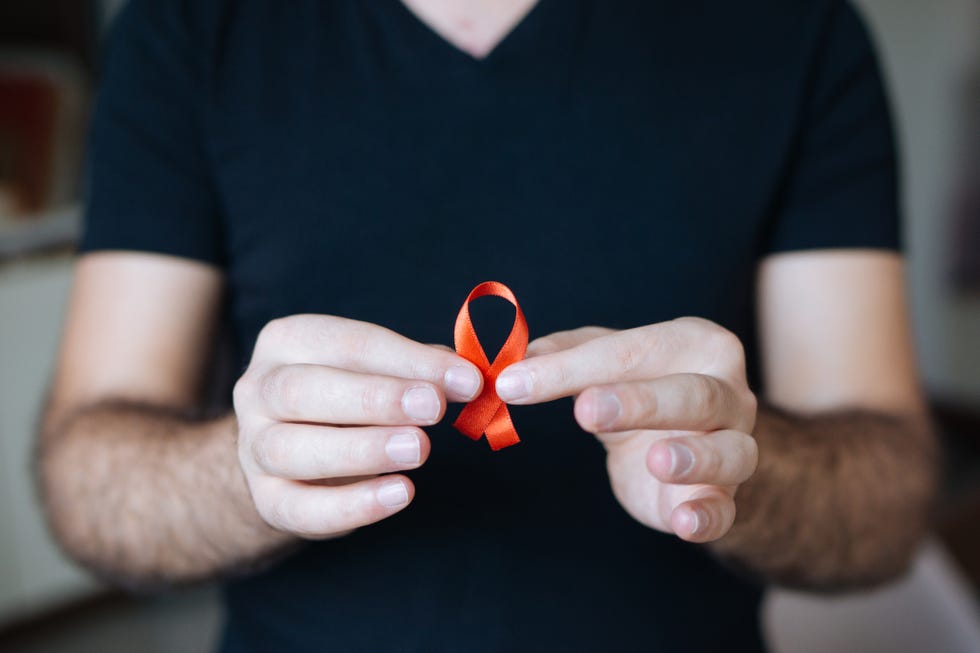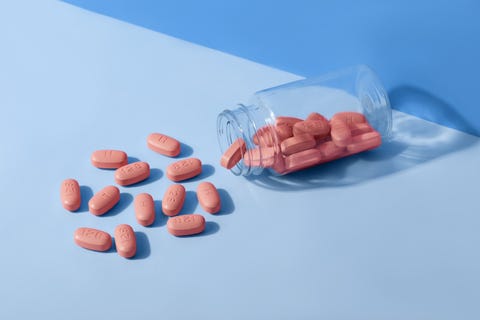
On a basic level, most of us are familiar with HIV, the virus that can progress to AIDS. HIV attacks your body’s immune system, especially your CD4 cells, which are vital to helping your body fight off infection. The virus can reduce the number of those infection-fighting cells, making you more vulnerable to certain infections and disease, according to the Centers for Disease Control and Prevention (CDC).
In 2018, the most recent year for which new HIV infection data is available, 30,691 men received an HIV diagnosis in the U.S. While HIV cases are on the decline in general, it’s still a serious problem, especially in certain groups. For instance, male-to-male sexual contact accounted for 65% of all new HIV infections in 2019, according to the CDC. And some racial groups are more heavily affected, too, particularly African American and Hispanic people. In fact, African Americans make up 12% of the U.S. population, but account for 42% of all new HIV diagnoses.
HIV has been in the public eye since the early 1980s, and since that time, misconceptions about the disease have abounded. Price’s comments only emphasize the importance of getting the real facts out to the public, says Carlos Malvestutto, M.D., M.P.H, who specializes in infectious disease at Ohio State University Wexner Medical Center.
“There are definitely misperceptions that seem to have a surprising amount of staying power,” he says.
Here are 8 myths about HIV that have lingered, and the truths that should dispel them for good.
HIV Myth: Transmission is always a high risk from people with HIV
For decades, this was actually true. “There’s a reason they called it an epidemic,” Malvestutto says. “But we’ve come a very long way since the 1980s in terms of learning how to control transmission.”
But with new medical advances like antiretrovirals, which lower the level of HIV in your body—known as the viral load—it’s simply not the case anymore. In fact, there’s a catchy mnemonic in the infectious disease world now: U=U. If your HIV is undetectable—meaning the viral load is low enough so it doesn’t show up on blood tests—then it’s very unlikely to be transmitted.
“There are numerous studies to support this, and the CDC supports this, because the data is consistent,” Malvestutto says. “So, although we still encourage condom use to prevent other STDs, the risk of HIV is just not there if the condom breaks.”
According to a letter from the CDC, “people who take ART daily as prescribed and achieve and maintain an undetectable viral load have effectively no risk of sexually transmitting the virus to an HIV-negative partner.”
HIV Myth: HIV shortens your lifespan considerably
If you’re undergoing antiretroviral treatment and your viral load is undetectable, then you have about the same lifespan as someone without HIV, Malvestutto explains. According to a study published in The Lancet, people who started antiretroviral therapy during 2008 to 2010 with CD4 cell counts above 350 (a marker of immune health) one year after initiation have an estimated life expectancy approaching that of the general population.
Some research suggests you might live a few months less than someone non-infected, he says, but in general, you can count on a pretty normal lifespan.
However, there is one caveat to that: heart disease. People with HIV can have double the risk of heart attack, according to Northwestern University researchers. Malvestutto says more research needs to be done to determine why that might be, but it’s likely related to chronic inflammation that’s caused by the infection, even when it’s being suppressed.
That means it’s even more important for those with HIV to reduce heart attack and stroke risk with lifestyle measures like quitting smoking, exercising, eating healthy, and controlling high blood pressure. (Here’s how 3 former smokers finally quit for good.)
“Our patients aren’t dying of AIDS anymore, they’re dying of heart disease,” Malvestutto says. “So, in some ways, you may have a shorter lifespan if you have HIV, but there are many factors you can control to reduce the risk of that.”
HIV Myth: If you have HIV, you take a “cocktail” of drugs with ample side effects
This myth is persistent because, like the transmission myth, it was once true but isn’t any longer. In the early days of HIV treatment, those with the virus had to take numerous medications that often had terrible side effects—particularly when their disease had progressed to AIDS, says Malvestutto. These included things like severe muscle pain, fatigue, nausea, vomiting, and headache.
Although some people may have to take a few medications now to control the virus—depending on how advanced your HIV might be—the majority take only pill per day, and that has few reported side effects and very minimal toxicity, Malvestutto says. There are several options in terms of once-daily, single-tablet regimens, but all have antiretroviral properties.
“Some people are afraid of going on treatment because they think they’ll get incredibly sick,” Malvestutto says. “We simply don’t see that anymore. The majority of people just take their pill to keep the virus suppressed, and have no side effects at all.”

YakubovAlimGetty Images
HIV Myth: Only gay men and IV drug users get HIV
This particular myth is curiously persistent, according to Gabriel Rebick, M.D., specializing in infectious disease and immunology at NYU Langone Health.
“I see a lot of heterosexuals who thought they couldn’t get HIV, and that’s obviously not true,” he says.
The risks are higher people who have anal sex, the most transmissive way to get HIV. That’s because the lining of the rectum is thin and can develop micro-tears that allow HIV-infected semen to enter the bloodstream. People who use IV drugs are also a high-risk group since they can share needles, and even a small amount of blood from one person to the next can cause infection.
But that doesn’t mean everyone else is in the clear. In fact, a 2016 report from the CDC found that heterosexuals accounted for 25 percent of the new HIV cases in 2010. And of the number of new heterosexuals infected in that year, 34 percent of them were men.
HIV Myth: You can tell who has HIV because they will seem sick
One of the most difficult aspects of recognizing HIV is the lack of symptoms, which is what has made the epidemic into, well, an epidemic. Yet some people still believe that those with HIV will “seem sick,”—like having flu-like symptoms or lesions—so having sex with someone who seems perfectly healthy presents no risk. Unfortunately, that’s not the case.
“Especially early on, there’s rarely an indication of infection,” Rebick says. “That’s why it’s important to get tested if you’re sexually active and have multiple partners, or if you’re an IV drug user. Or, really, anyone.”
The CDC recommends all adults get screened for HIV at least once, and people at higher risk, like sexually active gay men, at get re-screened at least annually.
HIV Myth: Condoms and clean needles are the only way to prevent HIV transmission
Yes, those are great prevention tools. But here’s another wonder of the modern infectious disease era: a drug called Truvada.
This is a pre-exposure prophylaxis (PrEP) treatment that comes in the form of a single pill taken daily by people who don’t have HIV to help prevent against HIV infection. It works by blocking the HIV virus from attacking the immune system. It’s often used for those who are at substantial risk of infection, such as people in high-risk groups.
Approved in 2012 by the U.S. Food and Drug Administration (FDA) for PrEP , the drug still isn’t readily available in some parts of the country, since it’s taking some time for the regimen to become widely accepted, Malvestutto says. But it’s widely used in larger urban areas like New York City and San Francisco, and it’s been a game changer for HIV prevention.
“With this drug, which is very safe and has minimal to no side effects, you can be exposed to HIV and you’ll be protected,” he says. “It’s contributing to reducing the risk of transmission. I have some patients who’ve been on it for years.” (Still, it won’t protect against other STDs, so condoms are still needed for that.)
HIV Myth: If you are exposed to HIV, there’s nothing you can do to prevent infection
There is, actually, a kind of Plan B for HIV, and it’s a strategy called post-exposure prophylaxis, or PEP.
These are antiretroviral medicines that must be administered within 72 hours—although sooner is better—in the case of potential HIV exposure. You take them for 28 days, and the treatment significantly reduces the risk of infection, according to Malvestutto.
HIV Myth: You can easily get HIV from any exchange of fluids, including oral sex
Nope. HIV is transmitted through blood or semen, but the CDC emphasizes that you have “little to no risk” of getting or transmitting HIV from oral sex, because of the low chances of semen entering the bloodstream. Still, it can occur if there are sores in the mouth or penis, or bleeding gums.
The risk is even lower with kissing unless you have some serious gum disease issue on both sides. But the chances of that happening are incredibly low.
“This is actually one of the biggest misconceptions we hear,” Rebick says. “People think you can HIV from hugging, or being in close contact with someone who has the virus. Some people even think it can airborne. All of that is simply untrue.”
This content is created and maintained by a third party, and imported onto this page to help users provide their email addresses. You may be able to find more information about this and similar content at piano.io
